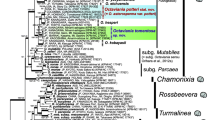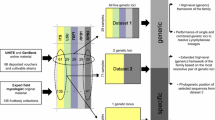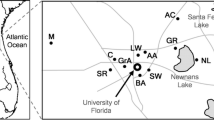Abstract
The molecular phylogeny and comparative morphological studies reported here provide evidence for the recognition of the genus Picoa, an hypogeous desert truffle, in the family Pyronemataceae (Ascomycota, Pezizales). Picoa juniperi and Picoa lefebvrei were reassigned to the genus Picoa based on large subunit (LSU) sequence (28S) rDNA and internal transcribed spacer (ITS) rDNA (including the partial 18S, ITS1, ITS2, 5.8S gene, and partial 28S of the nuclear rDNA) data. Morphological studies of spores, asci, perida, and gleba revealed high similarities between P. lefebvrei and P. juniperi, thereby confirming the membership of both species in the genus Picoa. These two species were primarily distinguishable based on ascospore ornamentation.



Similar content being viewed by others
References
Al-Scheikh M, Trappe JM (1983) Taxonomy of Phaeangiurn lefebvrei, a desert truffle eaten by birds. Can J Bot 61:1919–1925
Ammarellou A, Trappe JM (2007) A first Ascomycete genus (Picoa sp) record for the fungi flora of Iran. Pak J Biol Sci 10:1772
Ferdman Y, Aviram S, Roth-Bejerano N, Trappe JM, Kagan-Zur V (2005) Phylogenetic studies of Terfezia pfeilii and Choiromyces echinulatus (Pezizales) support new genera for southern African truffles: Kalaharituber and Eremiomyces. Mycol Res 109:237–245
Fischer E (1897) Ascomyceten: Tuberaceen und Hemiasceen, Rabenhorst's Kryptogamen—Flora von Deutschland, Oesterreich und der Schweiz, vol 1. Fischer, Vienna
Gutiérrez A, Morte A, Honrubia M (2003) Morphological characterization of the mycorrhiza formed by Helianthemum almeriense Pau with Terfezia claveryi Chatin and Picoa lefebvrei (Pat) Maire. Mycorrhiza 13:299–307
Harold H, Burdsall JR (1965) Operculate asci and puffing of ascospores in Geopora (Tuberales). Mycologia 57:485–488
Harold H, Burdsall JR (1968) A revision of the genus Hydnocystis (Tuberales) and of the hypogeous species of Geopora (Pezizales). Mycol 60:496–525
Henrion B, Chevalier G, Martin F (1994) Typing truffle species by PCR amplification of the ribosomal DNA spacers. Mycol Res 98:37–43
Jack SS, Gaud WS (1997) Ecology of hypogeous fungi associated with ponderosa pine I patterns of distribution and sporocarp production in some Arizona forests. Mycologia 89:712–721
Kovacs GM, Trappe JM, Alsheikh AM, Boka K, Elliott TF (2008) lmaia, a new truffle genus to accommodate Terfezia gigantean. Mycologia 100:930–939
Læssøe T, Hansen K (2007) Truffle trouble: what happened to the Tuberales? Mycol Res 111:1075–1099
Lange M (1956) A new species of Picoa. Mycologia 48:877–878
Li LT (1997) Ultrastructural studies of Leucangium carthusianum (hypogeous Pezizales). Int J Plant Sci 158:189–197
Maire R (1906) Notes mycologiques. Ann Mycol 4:329–399
Moreno G, Diez GJ, Manjon JL (2000a) Picoa melospora sp nov (Pezizales) from the Iberian Peninsula. Bull Fed Assoc Mycol Medit 18:87–92
Moreno G, Diéz J, Manjón JL (2000b) Picoa lefebvrei and Tirmania nivea, two rare hypogeous fungi from Spain. Mycol Res 104:378–381
O’Donnell K, Cigelnic E, Weber NS, Trappe JM (1997) Phylogenetic relationships among ascomycetous truffles and the true and false morels inferred from 18S and 28S ribosomal DNA sequence analysis. Mycologia 89:48–65
Palfner G, Agerer R (1998) Leucangium carthusianum (Tul) Paol (=Picoa carthusiana Tul and Tul) + Pseudotsuga menziesii (Mirb). Franco Descr Ectomyc 3:37–42
Patouillard N (1894) Les térfez de la Tunisie. J Bot 8:153–156
Rambaut A (2008) FigTree v111: Tree figure drawing tool. Available at: http://treebioedacuk/software/figtree/
Ronquist F, Huelsenbeck JP (2003) MrBayes 3: Bayesian phylogenetic inference under mixed models. Bioinformatics 19:1572–1574
Sambrook J, Fritsh EF, Maniatis T (1989) Molecular cloning: a laboratory manual, 2nd edn. Cold Spring Harbor Laboratory Press, Cold Spring Harbor
Slama A, Fortas Z, Neffati M, Khabar L, Boudabbous A (2006) Etude taxonomique de quelques Ascomycota hypogés (Terfeziaceae) de la Tunisie méridionale. Bull Soc Mycol Fr 122:187–195
Smith ME, Healy RA (2009) Otidea subterranea sp. nov.: Otidea goes below ground. Mycol Res 113:858–866
Stamatakis A, Ludwig T, Meier H (2005) RAxML III: a fast program for maximum likelihood-based inference of large phylogenetic trees. Bioinformatics 21:456–463
Tamura K, Dudley J, Nei M, Kumar S (2007) MEGA4: molecular evolutionary genetics analysis (MEGA) software version 40. Mol Biol Evol 24:1596–1599
Tedersoo L, May TM, Smith ME (2010) Ectomycorrhizal lifestyle in fungi: global diversity, distribution, and evolution of phylogenetic lineages. Mycorrhiza 20:217–263
Thompson JD, Gibson TJ, Plewniak F, Jeanmougin F, Higgins DG (1997) The ClustalX windows interface: flexible strategies for multiple sequence alignment aided by quality analysis tools. Nucleic Acids Res 25:4876–4882
Trappe JM (1971) A synoptis of the Carbomycetaceae and Terfeziaceae (Tuberales). Transact Brit Mycol Soc 57:85–92
Trappe JM (1979) The orders, families and genera of hypogeous Ascomycotina (truffles and their relatives). Mycotaxon 9:297–340
Tulasne LR, Tulasne C (1862) Fungi hypogeai. Klinchsieck, Paris
Vilgalys R, Hester M (1990) Rapid genetic identification and mapping of enzymatically amplified ribosomal DNA from several Cryptococcus species. J Bacteriol 172:4238–4246
Vittadini C (1831) Monographia tuberacearum. Felicis rusconi, Milan
Wei J, Peršoh D, Agerer R (2010) Four ectomycorrhizae of Pyronemataceae (Pezizomycetes) on Chinese Pine (Pinus tabulaeformis): morpho-anatomical and molecular-phylogenetic analyses. Mycol Prog. 9. doi: 10.1007/s11557-009-0637-x
White TJ, Bruns TD, Lee S, Taylor JW (1990) Amplification and direct sequencing of fungal ribosomal RNA genes for phylogenetics. In: Innis MA, Gelfand DH, Sninsky J, White TJ (eds) PCR protocols: a guide to methods and applications. Academic, San Diego
Acknowledgments
This work was partially supported by grants from the High Education and Scientific Research Ministry of Tunisia and the EU Project BIODESERT 245756 (FP7-Capacities-RegPot 2009-2). We thank Dr. Fatma MASMOUDI (CERT, Borj-Cedria) for helpful and assistance in the SEM observations.
Author information
Authors and Affiliations
Corresponding author
Rights and permissions
About this article
Cite this article
Sbissi, I., Neffati, M., Boudabous, A. et al. Phylogenetic affiliation of the desert truffles Picoa juniperi and Picoa lefebvrei . Antonie van Leeuwenhoek 98, 429–436 (2010). https://doi.org/10.1007/s10482-010-9456-y
Received:
Accepted:
Published:
Issue Date:
DOI: https://doi.org/10.1007/s10482-010-9456-y




